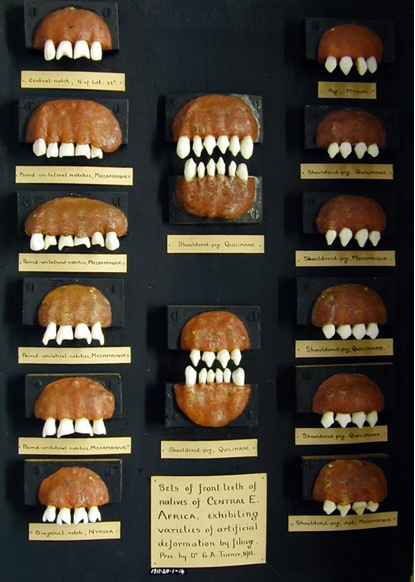Shaped Teeth
Mozambique, Malawi and Tanzania, before 1910
 Donated by Dr G.A. Turner in 1911; 1911.20.1–.14
Donated by Dr G.A. Turner in 1911; 1911.20.1–.14
This old museum display board shows several sets of human teeth from areas of central-eastern and south-eastern Africa. They have been filed or chipped into various desired shapes and set into clear resin painted brick-red.
The Dogon of Mali in Africa file their teeth into sharp points to create an effect similar to the sets of teeth in the centre of this board. For the Dogon, pointed teeth resemble the teeth of a comb and thus evoke the loom, the metaphor residing in speech issuing from between the teeth as the source of action that 'weaves' the world. This contrasts to Bali where pointed teeth are associated with evil monsters so people's teeth are filed flat. Among the Makonde of Tanzania chipped teeth, such as those on the left-hand side of the board, showed that a person had gone through the ritual of initiation and attained a new status as a full adult member of their community. However, like other Makonde marks of identity such as lip plugs, the practice of teeth filing and chipping is dying out with the modern forces of social change, Christianization, education and urbanization. Such changes are not simply an abandonment of outlandish or painful practices, but demonstrate the dynamic nature of cultural traditions. Concepts about what constitutes elegance and beauty are continually shifting, as they do elsewhere, with time and circumstance.
Smiles can be modified by removing teeth altogether. Tooth avulsion is the practice of knocking out teeth at the root and aboriginal peoples in Central Australia practised it for several thousand years. Although no longer done, it indicated the attainment of social status once a boy reached maturity. Done using a stick and no anaesthetic, it was a very painful procedure but this added to the sense of occasion, bravery and achievement for the boy. Among the Dinka of Sudan both boys and girls may have four to six of the lower front teeth removed in childhood as a mark of initiation and beauty. Again, this practice is declining but there have been incidences in recent years of Sudanese refugees in America being placed on waiting lists for dental implants because their traditional gap-toothed appearance was deemed a hindrance to their development of the English language, processing of American foods, and advancement in Western society.
